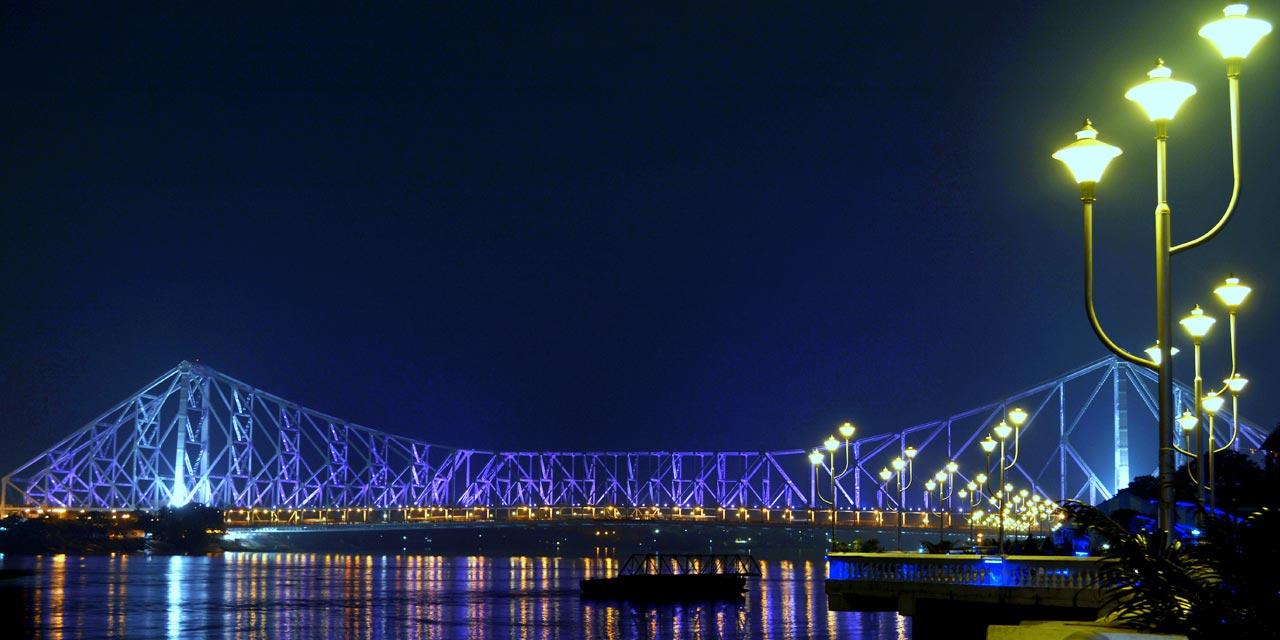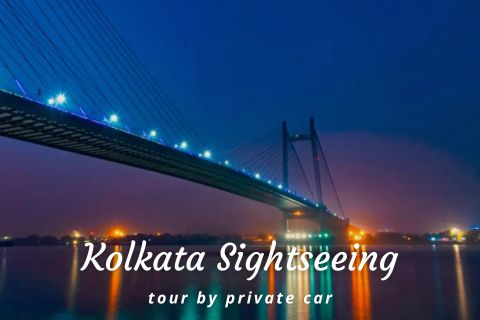
Howrah Bridge Kolkata Entry Fee
- No entry fee
Howrah Bridge Kolkata Phone
033 2259 0264
Rating:  | 4/5 stars
| 4/5 stars
Based on total 51 reviews
Howrah Bridge Kolkata Address: Jagganath Ghat, 1, Strand Road, Kolkata, West Bengal, 700001, India
The Howrah Bridge is synonymous to Kolkata, and has remained the face to the City of Joy since antiquity. One of the early engineering and architectural marvels of Bengal, the bridge is sixth longest suspended span cantilever bridge in the world.
Howrah Bridge has been standing strong for the past 76 years, with no pillars supporting its suspension over the Hooghly River and has also witnessed several historical events including the World War II. It is an icon of Bengal’s history and culture, connecting Kolkata to Howrah. Being gateway to Kolkata, anyone who enters Kolkata has to pass through this bridge to reach other parts of the state.
The bridge is 705m long and boasts of 8 lanes jointly 97m wide, serves gateway to around 200,000 vehicles and around 150,000 pedestrians every day, which makes it the world's busiest cantilever bridge. It was formally re- named as Rabindra Setu in 1965, after the famous poet and Nobel Laureate, Rabindra Nath Tagore. However; it still remains popular as Howrah Bridge.
The bridge celebrated its 75th anniversary in February 2018. It was decorated with multi- coloured flags by the Kolkata Port Trust authority.
Architecture of Howrah Bridge
Having being built without a single nut and bolt, the architecture of Howrah Bridge is a marvel on its own. The entire structure is riveted. Being unique and one of its kind in the world at the time when it was built, the bridge was officially classified as ‘Suspension Type Balanced Cantilever’. It was the third longest cantilever bridge when it was commissioned.
There are 39 pairs of hangers suspended from the main trusses from which the bridge deck hangs. A total of 20,000 tonnes of steel was required to construct the bridge, out of which only 3000 tonnes were supplied from England and the remaining 23,000 tonnes of high tension steel was commissioned from Tata Steel named TISCROM.
The main tower was constructed with single monolith caissons. All the work was carried out below ground level. The work on the foundation was completed by 1938 and, by the mid- summer of 1941, the cantilevered arms were erected. Each half of the suspended span weighs 2000 tonnes and a length of 282 feet.
The cost of the entire project was 25 million (GBP 2,463,887).
Image Gallery of Howrah Bridge Kolkata
History of Howrah Bridge
The First Howrah Bridge
The story of Howrah Bridge goes back to 1862 as Calcutta; the then capital of British India started growing busier each day. The need for a strong connectivity between the two principal districts, Howrah and Calcutta, which were separated by the Hooghly River, became important. Subsequent to the formation of Calcutta Port Trust in 1870, and via Howrah Bridge act of 1871, the first Pontoon Bridge between the two places completed in 1874. Parts of the bridge were shipped from England and assembled in India. This bridge was 465.7 meters long and 19 meters wide with pavements measuring 2.1 meters on either side.
Since the bridge was at a lower level, it had to be unfastened at regular intervals for the steamers and other water transports to pass. This bridge did serve the purpose for the time being but it wasn’t strong enough to bear the weight of heavy vehicular traffic and could not stand rough weather. Hence, the Port Commissioners felt the need for a robust alternative and put forth their proposal to build a sturdier bridge.
The New Howrah Bridge
Based on the high traffic requirements that the new bridge had to deal with, the 1906 committee decided up on a floating bridge to be built that would serve the traffic requirements. Tenders were extended and a price amount was set for whoever came out with the best design and construction plan. This entire plan came to a standstill due to World War I.
After the World War, another committee named ‘Mukherjee Committee’ comprising a team of engineers led by Sir R. N. Mukherjee was set up in 1921 to resume the work on The New Howrah Bridge. During their discussion of the report with Sir Basil Mott, he suggested that a single span arch bridge be built over Hooghly.
The Mukherjee Committee submitted their report to the newly formed New Howrah Bridge Commission and the entire contract of the work was secured by Cleveland Bridge and Engineering Company Ltd, a British company. The final design of the new bridge was done by chief draftsman of M/s. Rendel, Palmer and Tritton, namely, Mr Walton on the basis of recommendations of the Goode committee in 1930. The Braithwaite Burn & Jessop Construction Company Limited, a local company was secured as the sub-contractor for steel works.
The construction of the bridge was completed in 1942 and opened for vehicular traffic on 3rd February, 1943. The first vehicle to run on the new Howrah Bridge was a solitary tram.
The World Wars
Coincidentally, the history of Howrah Bridge is correlated to both the World Wars. The initial work that was started in 1906 to build a new Howrah Bridge in replacement of the old Pontoon bridge was halted due to the First World War.
Even after the New Howrah Bridge Act was passed in 1922 and global tenders being floated in 1930, the work on the bridge was further delayed due to the anticipation of probable Second World War looming over.
The amount of steel required for building the bridge could not be supplied from England as it had to divert its steel supply for war efforts and, out of the total 26,000 tonnes of steel that was required only 3000 could be shipped from England. Finally, Tata Steel was approached by the Calcutta Port Trust for the provision of remaining 23,000 tonnes of steel. Tata steel supplied 23,000 tonnes of high tension steel that they had named TISCROM.
The construction of the bridge was taken forward even though government feared attacks by Japanese. This fear led to a low key opening of the bridge without any official inauguration function. There were many failed attempts to destroy the bridge by Japanese fighter planes, but the bridge survived due to swift action of 978 Balloon Squadron that set up huge balloons attached to ground by steel cables. These balloons prevented fighter planes to lower enough to hit the target whereas the planes would crash after getting stuck in the cables.
In 1993, trams were stopped from passing on the bridge due to traffic congestion and increased footfall.
Things to do near Howrah Bridge
Take a long walk on the Bridge
Take a walk along the length of this 705-meter bridge to get the feel of the city and its people. The bridge is busy all day long with vehicles plying across the twin cities of Howrah and Kolkata. Since the bridge has separate lanes for pedestrians, it makes easy to stroll on the bridge. The bridge also makes a perfect place for street photography and is a photographer’s delight.
Mallik Ghat Flower Market
Assumed to be Asia's largest flower market, Mallik Ghat flower market is located right under the shadow of Howrah on its east end. The business in flower market thrives from makeshift shacks and comes to life as early as 3:00 AM, making it the busiest in India. One would be bowled by the fragrance and the burst of colors spread throughout. The market is a hub for photographers.
Take a cruise on the Ganges
There are quite a few options of cruises on the Ganges, the options being breakfast cruise, lunch cruise, evening cruise and dinner cruise. Each trip lasts for 3 hours.
Sundarban Day Cruises
Sundarban National Park in the Bay of Bengal is the world's largest delta region and largest single block of tidal mangrove forest. The forest lies at the point of confluence of Ganges, Brahmaputra and Meghana and derives its name from the Sundari trees that grow in abundance in the region. The national park has been declared as UNESCO World Heritage Site that is home to the famous Royal Bengal Tiger and other fauna like crocodiles, monitor lizards, langurs, spotted deer, snakes and birds.
The day cruise to Sundarban starts from Godkhali Jetty near Howrah Bridge.
Magen David Synagogue
The Magen David Synagogue is located at the junction of Brabourne Road and Canning Street, at a distance of 1.6 km from Howrah Bridge. The synagogue complex also houses Neveh Shalom Synagogue, Kolkata's oldest existing synagogue. It was built by Elias David Ezra in memory of his father. The architectural style is that of Italian renaissance with brick red finish.
Places to visit nearby Howrah Bridge
Victoria Memorial, BBD Bagh, Millenium Park, Princep Ghat, Fort William, Birla Planetarium and St. Paul’s Cathedral are located nearby.
How to Reach Howrah Bridge
As the name suggests, Howrah Bridge is the 'Gateway to Kolkata'. It starts from a stone's throw distance from Howrah Junction Railway Station. One may either walk or hail a taxi to experience traveling through this marvel of a structure.
If you are entering Kolkata via air, you can simply hop into a taxi and reach here. You can also book a private cab from top car rental companies in Kolkata for a hassle free trip in the city visiting the popular sightseeing places of Kolkata.
We at Kolkata tourism, a division of Holidays DNA, help you make the most of your holiday with a wide variety of Kolkata tour packages. You can choose the package that suits your budget and preferences in the best possible manner. Please fill out the Contact Us form and we will get back to you.



